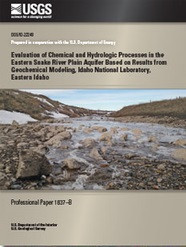
Product Details
- Product Number
- 523149
- Series
- PP-1837-A
- Scale
- NO SCALE
- Alternate ID
- 16-1837-A
- ISBN
- 978-1-4113-4249-1
- Authors
- GORDON W RATTRAY
- Version Date
- 01/01/2018
- Regions
- ID
- Countries
- USA
- Media
- Paper
- Format
- Bound
Additional Details
- Description
-
Abstract
Nuclear research activities at the U.S. Department of Energy (DOE) Idaho National Laboratory (INL) in eastern Idaho produced radiochemical and chemical wastes that were discharged to the subsurface, resulting in detectable concentrations of some waste constituents in the eastern Snake River Plain (ESRP) aquifer. These waste constituents may pose risks to the water quality of the aquifer. In order to understand these risks to water quality the U.S. Geological Survey, in cooperation with the DOE, conducted a study of groundwater geochemistry to improve the understanding of hydrologic and chemical processes in the ESRP aquifer at and near the INL and to understand how these processes affect waste constituents in the aquifer.
Geochemistry data were used to identify sources of recharge, mixing of water, and directions of groundwater flow in the ESRP aquifer at the INL. The geochemistry data were analyzed from 167 sample sites at and near the INL. The sites included 150 groundwater, 13 surface-water, and 4 geothermal-water sites. The data were collected between 1952 and 2012, although most data collected at the INL were collected from 1989 to 1996. Water samples were analyzed for all or most of the following: field parameters, dissolved gases, major ions, dissolved metals, isotope ratios, and environmental tracers.
Sources of recharge identified at the INL were regional groundwater, groundwater from the Little Lost River (LLR) and Birch Creek (BC) valleys, groundwater from the Lost River Range, geothermal water, and surface water from the Big Lost River (BLR), LLR, and BC. Recharge from the BLR that may have occurred during the last glacial epoch, or paleorecharge, may be present at several wells in the southwestern part of the INL. Mixing of water at the INL primarily included mixing of surface water with groundwater from the tributary valleys and mixing of geothermal water with regional groundwater. Additionally, a zone of mixing between tributary valley water and regional groundwater, trending southwesterly, extended from near the northeastern boundary of the INL to the southern boundary of the INL. Groundwater flow directions for regional groundwater were southwesterly, and flow directions for tributary groundwater were southeasterly upon entering the ESRP, but eventually began to flow southwesterly in a direction parallel with regional groundwater.
Several discrepancies were identified from comparison of sources of recharge determined from geochemistry data and backward particle tracking with a groundwater-flow model. Some discrepancies observed in the particle tracking results included representation of recharge from BC near the north INL boundary, groundwater from the BC valley not extending far enough south, regional groundwater that extends too far west in the southern part of the INL, and no representation of recharge from geothermal water in model layer 1 or recharge from the BLR in the southwestern part of the INL.
- Print Date
- 2018
- Height In Inches
- 11.000
- Width In Inches
- 0.500
- Length In Inches
- 9.000
- Two Sided
- No
- Pieces
- 1
- Languages
- English



